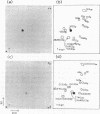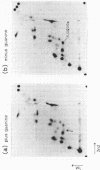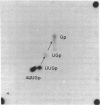Abstract
Guanylation of tRNA by a lysate of rabbit reticulocytes was reported previously by Farkas and Singh. This reaction was investigated further using 18 purified E. coli tRNAs as acceptors.Results showed that only tRNATyr, tRNAHis, tRNAAsn and tRNAAsp which contain the modified nucleoside Q in the anticodon acted as acceptors. Analysis of the nucleotide sequences in the guanylated tRNA showed that guanine specifically replaced Q base in these tRNAs.
Full text
PDF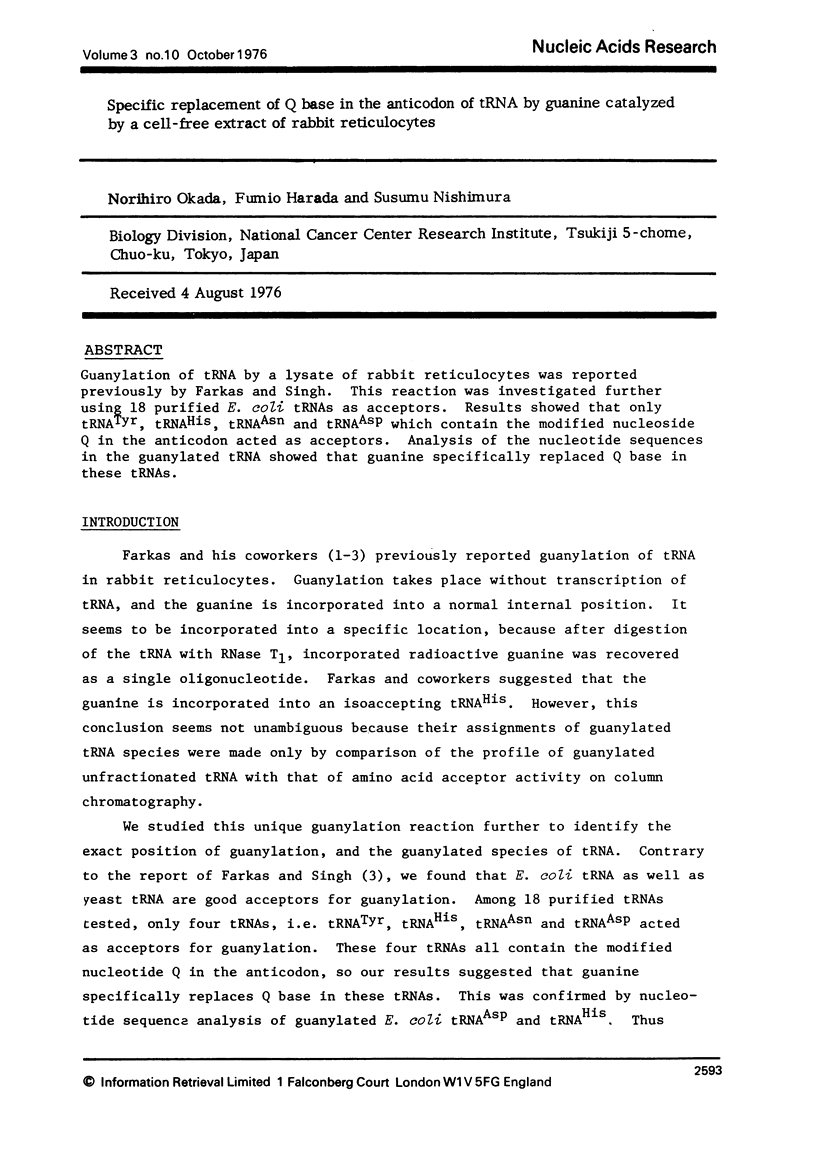
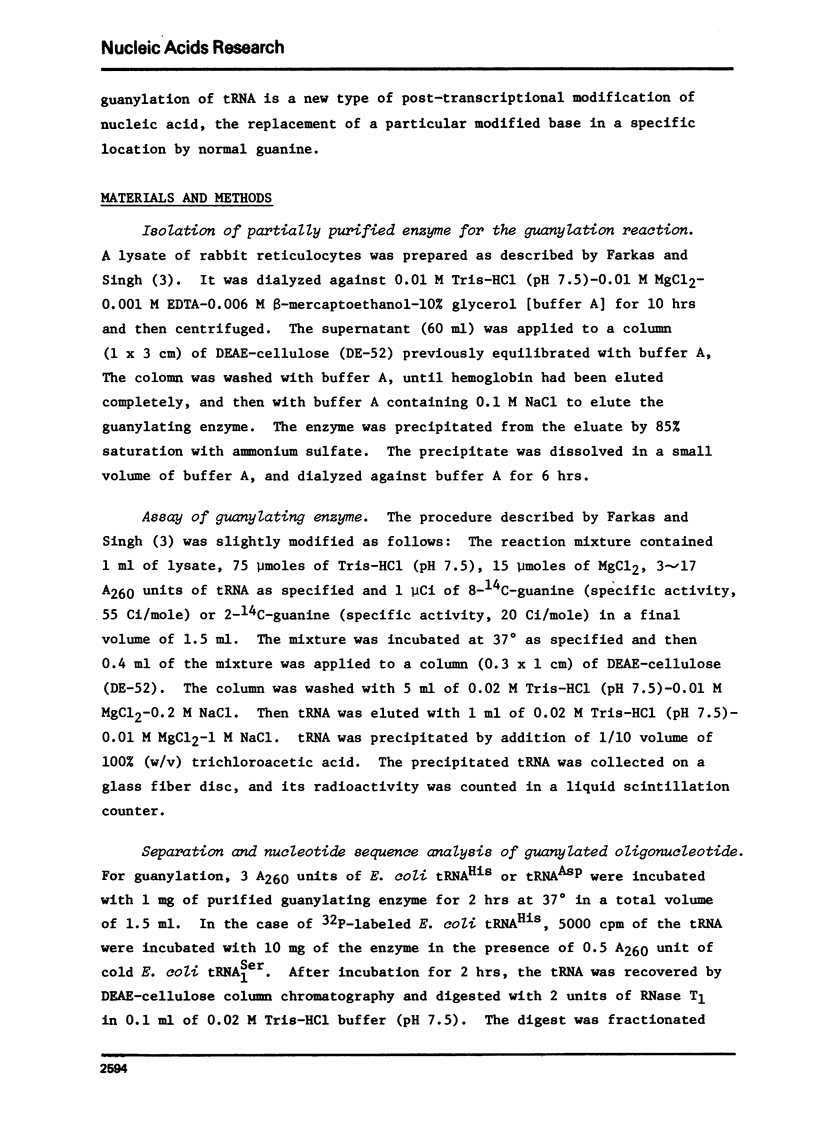
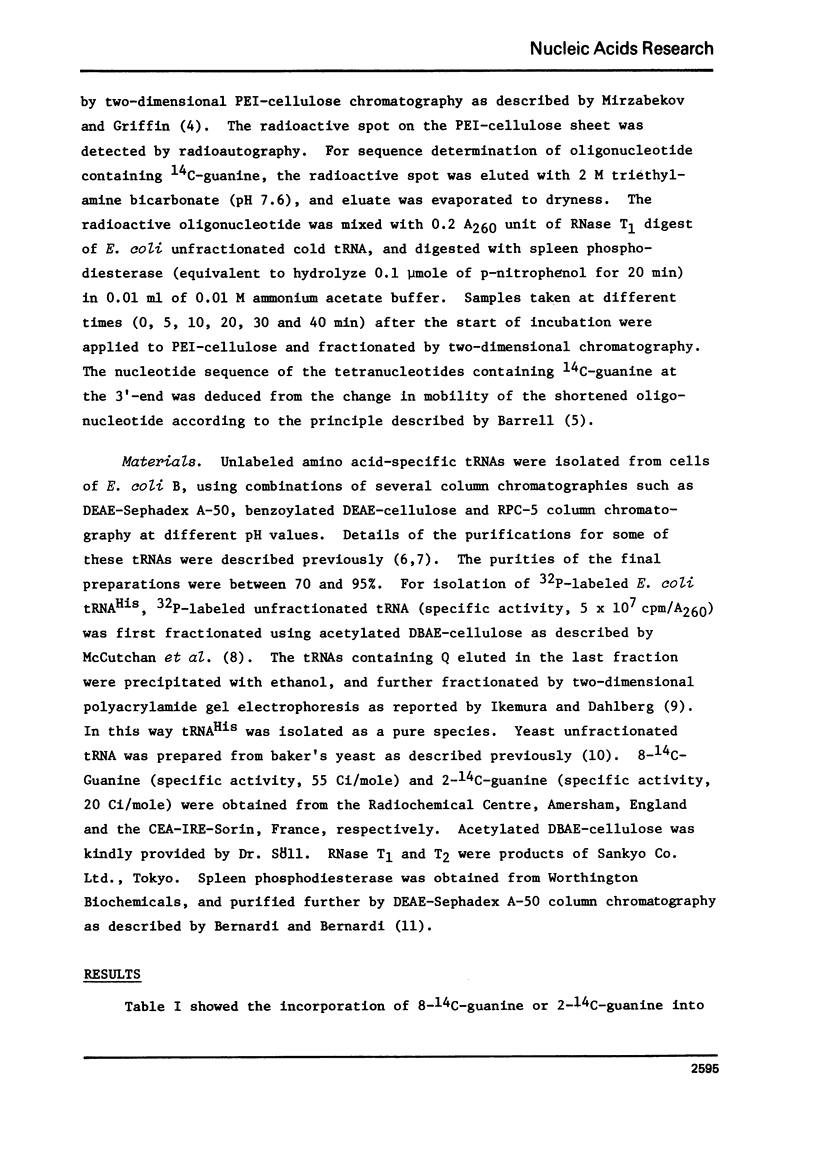
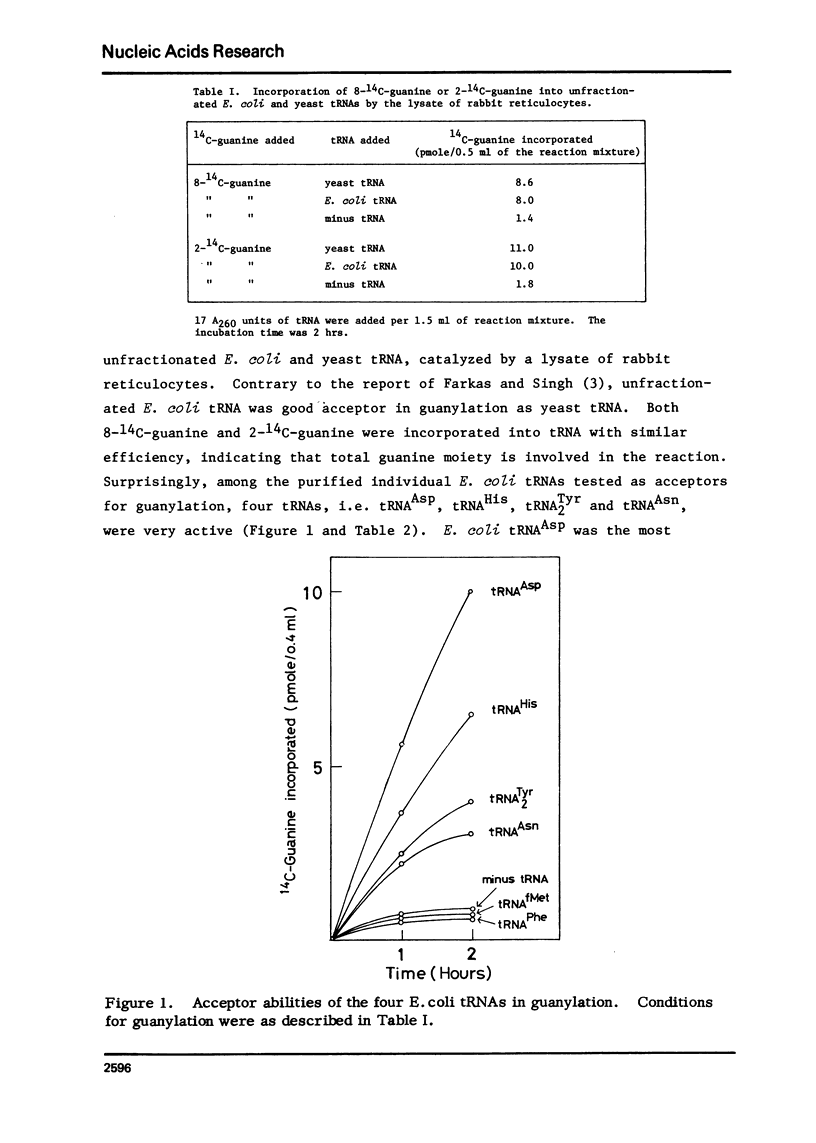
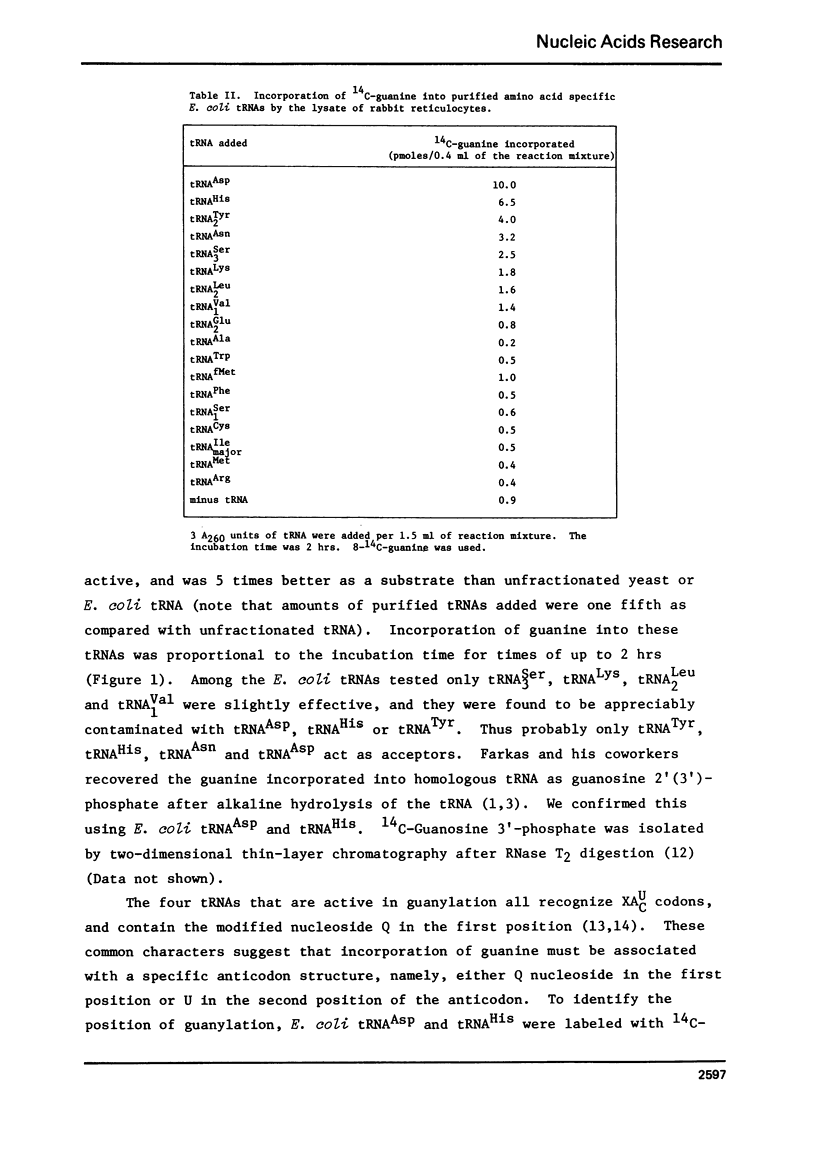
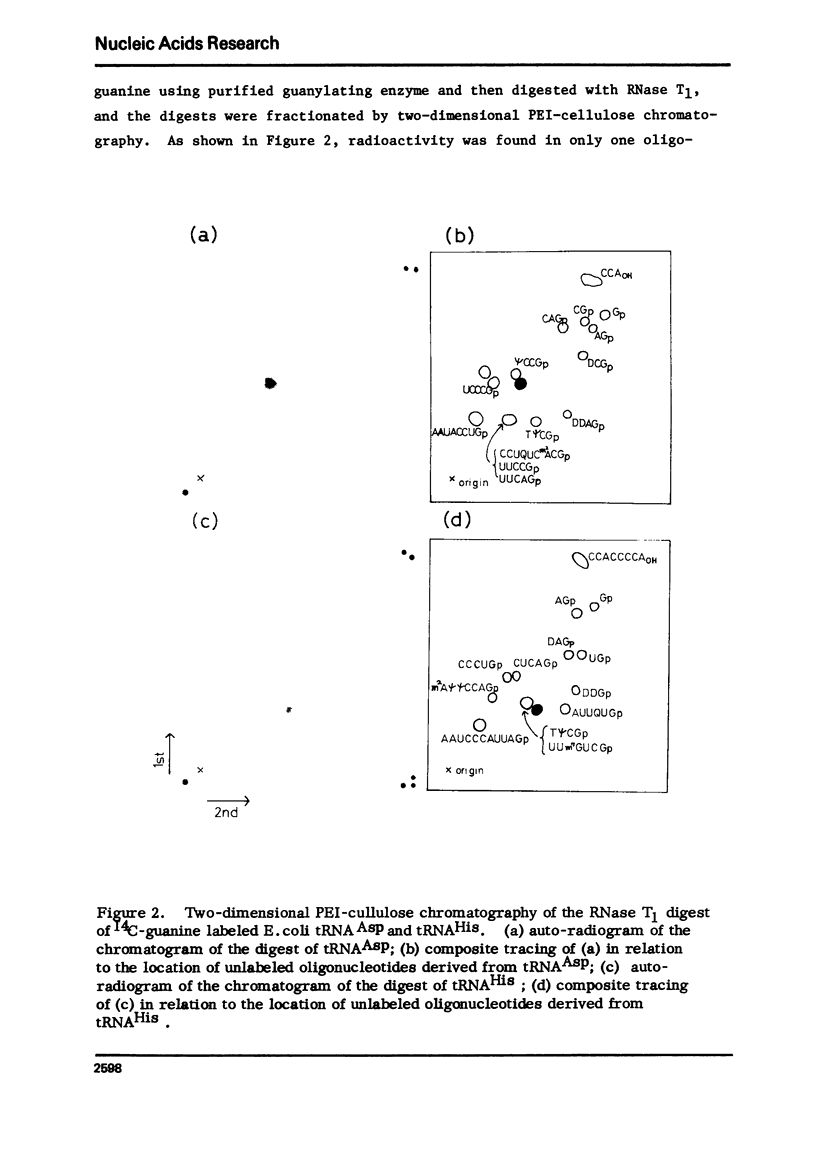
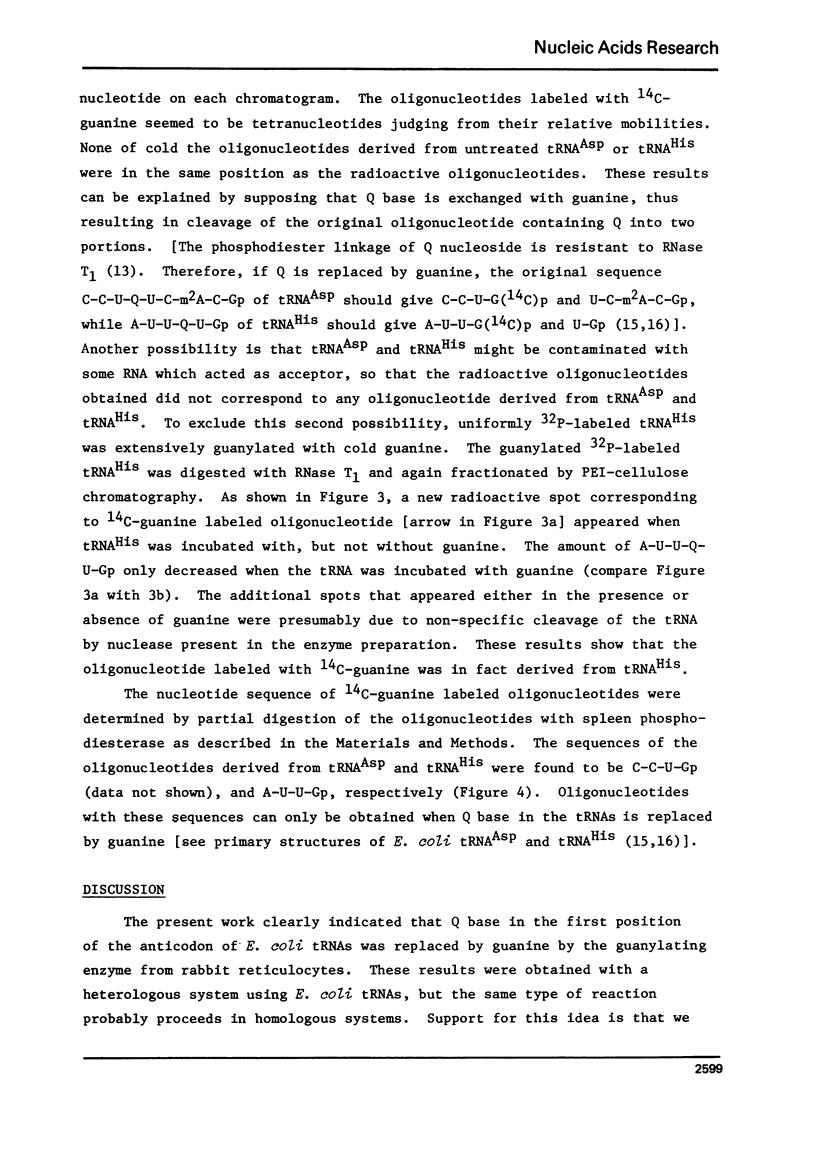
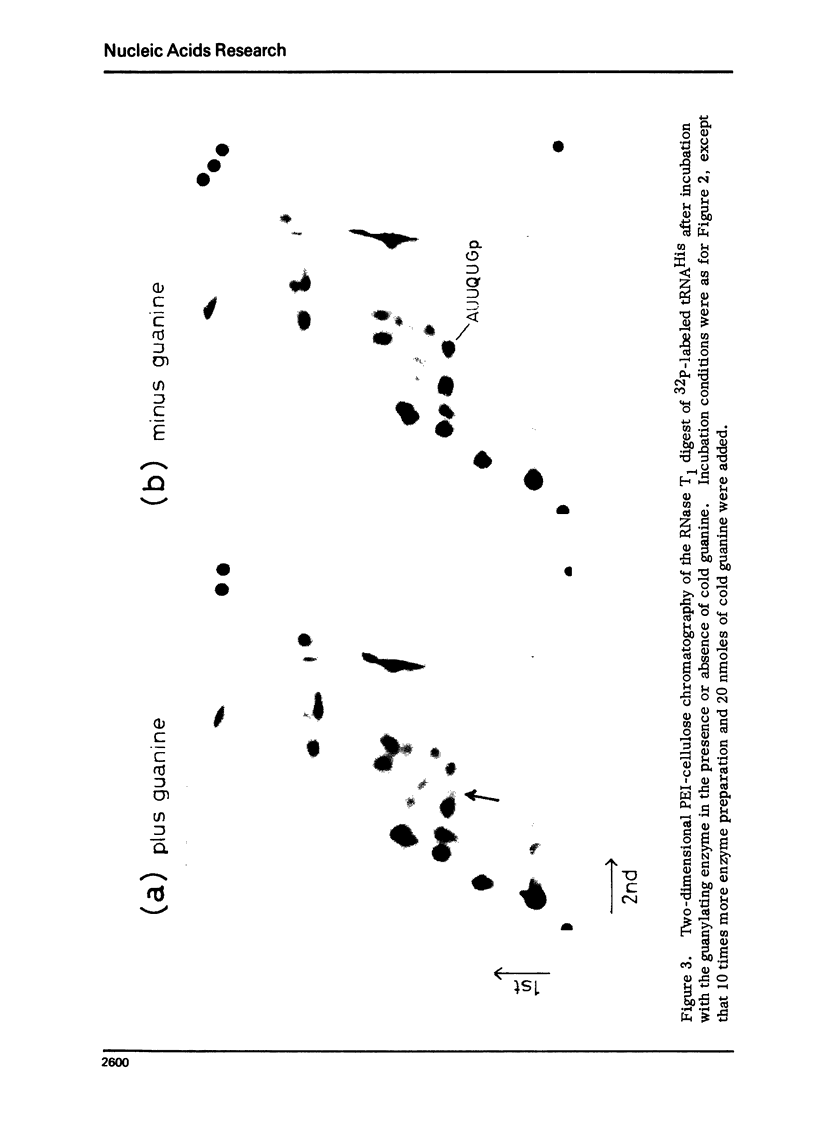
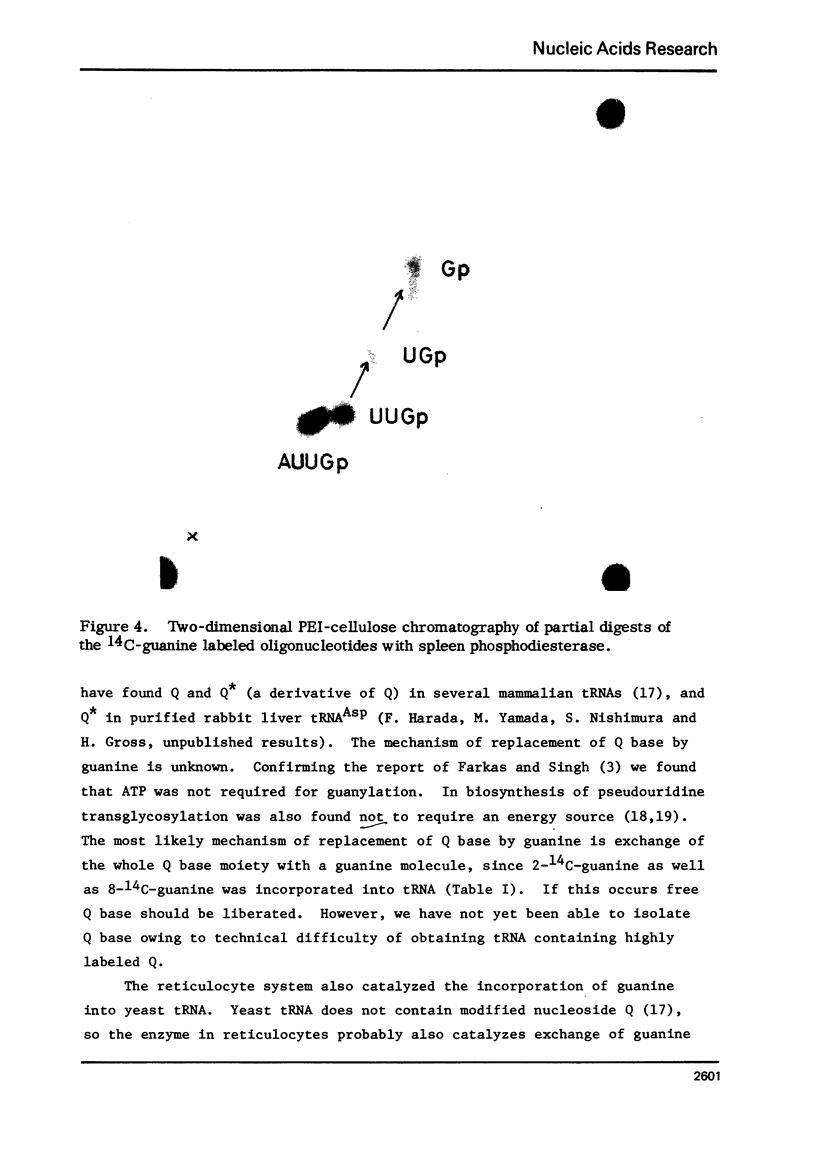
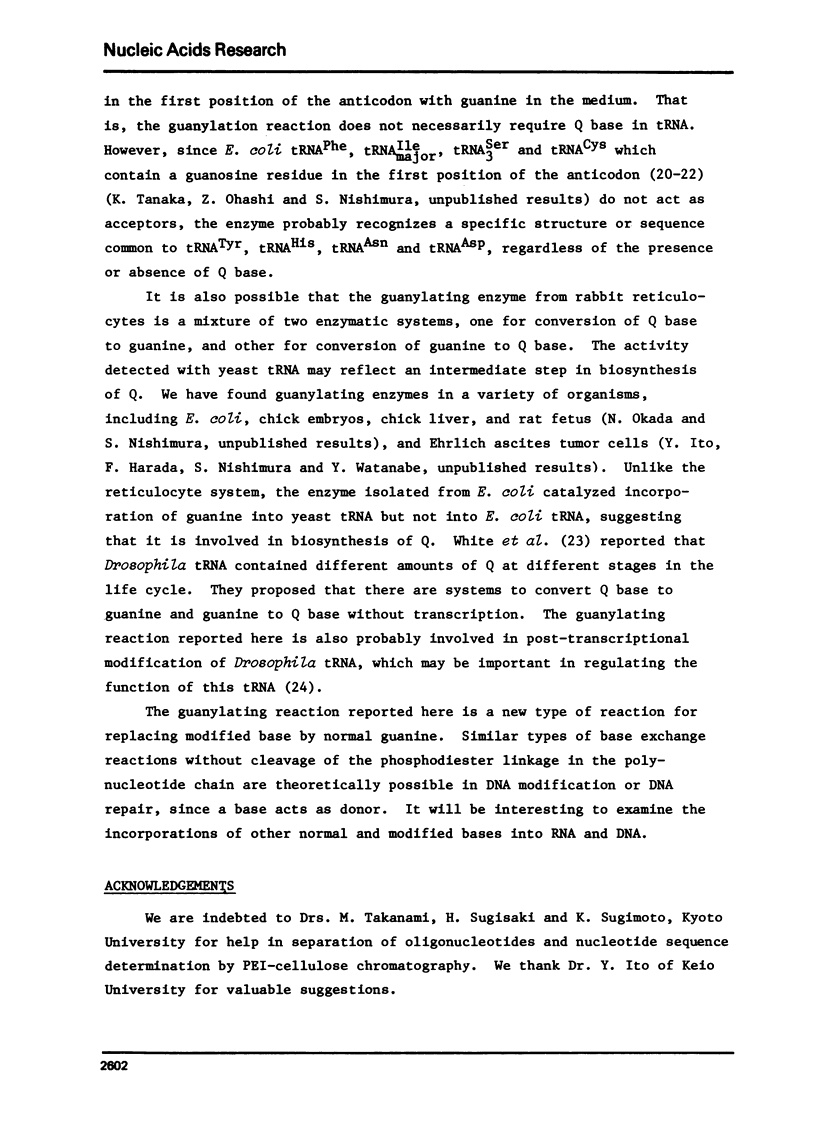
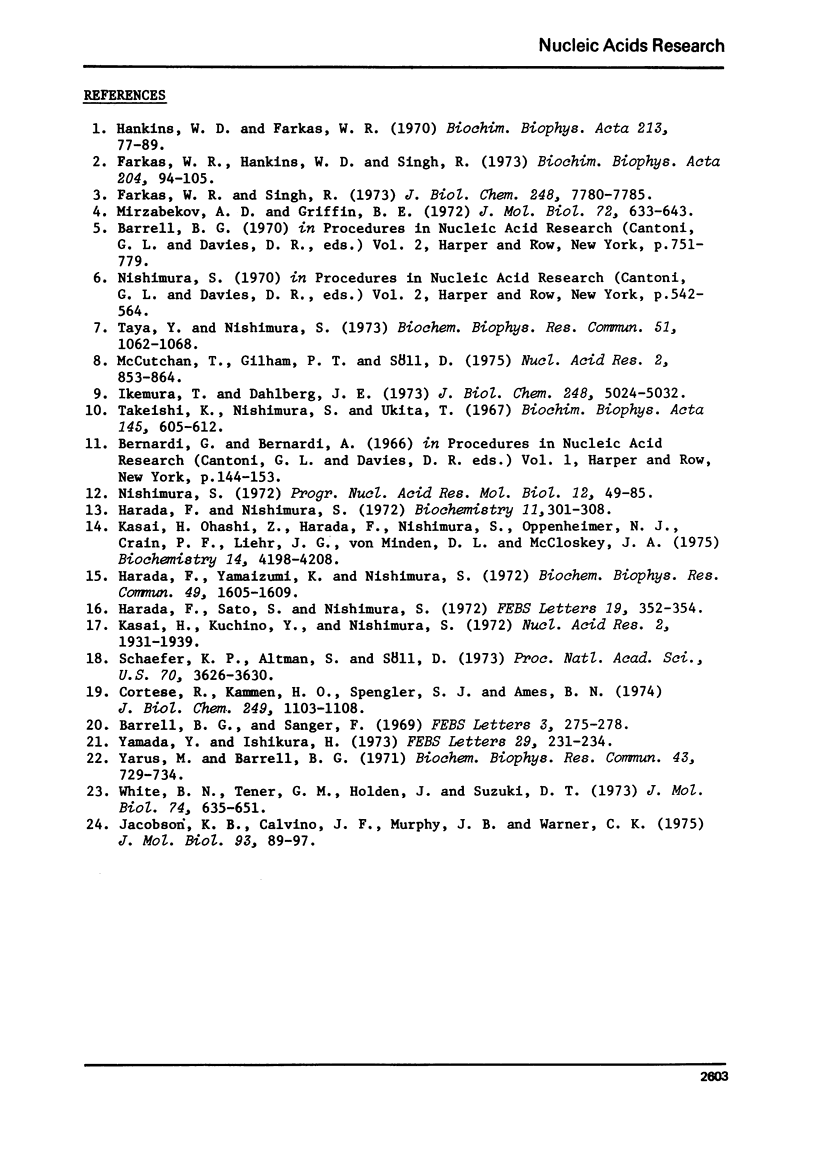
Images in this article
Selected References
These references are in PubMed. This may not be the complete list of references from this article.
- Barrell B. G., Sanger F. The sequence of phenylalanine tRNA from E. coli. FEBS Lett. 1969 Jun;3(4):275–278. doi: 10.1016/0014-5793(69)80157-2. [DOI] [PubMed] [Google Scholar]
- Cortese R., Kammen H. O., Spengler S. J., Ames B. N. Biosynthesis of pseudouridine in transfer ribonucleic acid. J Biol Chem. 1974 Feb 25;249(4):1103–1108. [PubMed] [Google Scholar]
- Farkas W. R., Singh R. D. Guanylation of transfer ribonucleic acid by a cell-free lysate of rabbit reticulocytes. J Biol Chem. 1973 Nov 25;248(22):7780–7785. [PubMed] [Google Scholar]
- Hankins W. D., Farkas W. R. Guanylation of transfer RNA by rabbit reticulocytes. Biochim Biophys Acta. 1970 Jul 16;213(1):77–89. doi: 10.1016/0005-2787(70)90009-2. [DOI] [PubMed] [Google Scholar]
- Harada F., Nishimura S. Possible anticodon sequences of tRNA His , tRNA Asm , and tRNA Asp from Escherichia coli B. Universal presence of nucleoside Q in the first postion of the anticondons of these transfer ribonucleic acids. Biochemistry. 1972 Jan 18;11(2):301–308. doi: 10.1021/bi00752a024. [DOI] [PubMed] [Google Scholar]
- Harada F., Sato S., Nishimura S. Unusual CCA-stem structure of E. coli B tRNAH(His)(1). FEBS Lett. 1972 Jan 1;19(4):352–354. doi: 10.1016/0014-5793(72)80078-4. [DOI] [PubMed] [Google Scholar]
- Harada F., Yamaizumi K., Nishimura S. Oligonucleotide sequences of RNase T 1 and pancreatic RNase digests of E. coli aspartic acid tRNA. Biochem Biophys Res Commun. 1972 Dec 18;49(6):1605–1609. doi: 10.1016/0006-291x(72)90525-6. [DOI] [PubMed] [Google Scholar]
- Ikemura T., Dahlberg J. E. Small ribonucleic acids of Escherichia coli. I. Characterization by polyacrylamide gel electrophoresis and fingerprint analysis. J Biol Chem. 1973 Jul 25;248(14):5024–5032. [PubMed] [Google Scholar]
- Jacobson K. B., Calviño J. F., Murphy J. B., Warner C. K. Mechanism of suppression in Drosophila. H. Enzymatic discrimination of wild-type and suppressor tyrosine transfer RNA. J Mol Biol. 1975 Mar 25;93(1):89–97. doi: 10.1016/0022-2836(75)90362-9. [DOI] [PubMed] [Google Scholar]
- Kasai H., Kuchino Y., Nihei K., Nishimura S. Distribution of the modified nucleoside Q and its derivatives in animal and plant transfer RNA's. Nucleic Acids Res. 1975 Oct;2(10):1931–1939. doi: 10.1093/nar/2.10.1931. [DOI] [PMC free article] [PubMed] [Google Scholar]
- Kasai H., Oashi Z., Harada F., Nishimura S., Oppenheimer N. J., Crain P. F., Liehr J. G., von Minden D. L., McCloskey J. A. Structure of the modified nucleoside Q isolated from Escherichia coli transfer ribonucleic acid. 7-(4,5-cis-Dihydroxy-1-cyclopenten-3-ylaminomethyl)-7-deazaguanosine. Biochemistry. 1975 Sep 23;14(19):4198–4208. doi: 10.1021/bi00690a008. [DOI] [PubMed] [Google Scholar]
- McCutchan T. F., Gilham P. T., Söll D. An improved method for the purification of tRNA by chromatography on dihydroxyboryl substituted cellulose. Nucleic Acids Res. 1975 Jun;2(6):853–864. doi: 10.1093/nar/2.6.853. [DOI] [PMC free article] [PubMed] [Google Scholar]
- Mirzabekov A. D., Griffin B. E. 5 s RNA conformation. Studies of its partial T 1 ribonuclease digestion by gel electrophoresis and two-dimensional thin-layer chromatography. J Mol Biol. 1972 Dec 30;72(3):633–643. doi: 10.1016/0022-2836(72)90181-7. [DOI] [PubMed] [Google Scholar]
- Nishimura S. Minor components in transfer RNA: their characterization, location, and function. Prog Nucleic Acid Res Mol Biol. 1972;12:49–85. [PubMed] [Google Scholar]
- Schaefer K. P., Altman S., Söll D. Nucleotide modification in vitro of the precursor of transfer RNA of Escherichia coli. Proc Natl Acad Sci U S A. 1973 Dec;70(12):3626–3630. doi: 10.1073/pnas.70.12.3626. [DOI] [PMC free article] [PubMed] [Google Scholar]
- Takeishi K., Nishimura S., Ukita T. Purification of histidine-specific transfer RNA from yeast. Biochim Biophys Acta. 1967;145(3):605–612. doi: 10.1016/0005-2787(67)90119-0. [DOI] [PubMed] [Google Scholar]
- Taya Y., Nishimura S. Biosynthesis of 5-methylaminomethyl-2-thiouridylate. I. Isolation of a new tRNA-methylase specific for 5-methylaminomethyl-2-thiouridylate. Biochem Biophys Res Commun. 1973 Apr 16;51(4):1062–1068. doi: 10.1016/0006-291x(73)90035-1. [DOI] [PubMed] [Google Scholar]
- White B. N., Tener G. M. Activity of a transfer RNA modifying enzyme during the development of Drosophila and its relationship to the su(s) locus. J Mol Biol. 1973 Mar 15;74(4):635–651. doi: 10.1016/0022-2836(73)90054-5. [DOI] [PubMed] [Google Scholar]
- Yamada Y., Ishikura H. Nucleotide sequence of tRNA(Ser)(3) from Escherichia coli. FEBS Lett. 1973 Feb 1;29(3):231–234. doi: 10.1016/0014-5793(73)80026-2. [DOI] [PubMed] [Google Scholar]
- Yarus M., Barrell B. G. The sequence of nucleotides in tRNA Ile from E. coli B. Biochem Biophys Res Commun. 1971 May 21;43(4):729–734. doi: 10.1016/0006-291x(71)90676-0. [DOI] [PubMed] [Google Scholar]



